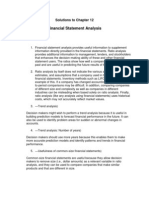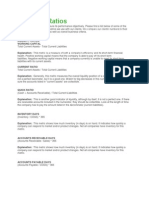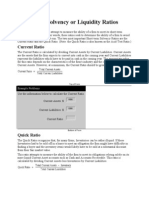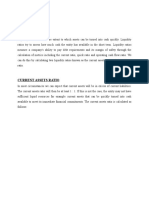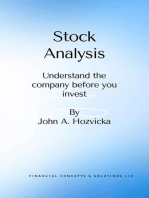Financial Ratios and Quality Indicators
Financial Ratios and Quality Indicators
Uploaded by
Sanny MostofaCopyright:
Available Formats
Financial Ratios and Quality Indicators
Financial Ratios and Quality Indicators
Uploaded by
Sanny MostofaOriginal Description:
Copyright
Available Formats
Share this document
Did you find this document useful?
Is this content inappropriate?
Copyright:
Available Formats
Financial Ratios and Quality Indicators
Financial Ratios and Quality Indicators
Uploaded by
Sanny MostofaCopyright:
Available Formats
Financial Ratios and Quality Indicators Monitoring ratios on a regular basis provides insight into how effectively a business
is being managed. Investors/Lenders also evaluate risk by using several sets of ratios; ratios of assets to liabilities, and ratios of lender-investor dollars to owner-investor dollars. Recognize that ratios are only indicators and that only management can tell the full story about a business. The more adept management is at e plaining financial ratios to their Investors/Lenders, the better they will understand your business. !ey "ndicators with their definitions, formula and analysis comments are discussed in the following pages# $age % &i'uidity# (inancial ratios in this category measure the company)s capacity to pay its debts as they come due. *urrent Ratio +uick Ratio $age , -afety# (inancial ratios in this category are indicators of the businesses) vulnerability to risk. *reditors to determine the ability of the business to repay loans often use these ratios. .ebt To /'uity .ebt *overage Ratio $age 0 1 2 $rofitability# The ratios in this section measure the ability of the business to make a profit. -ales 3rowth *43- to -ales 3ross $rofit Margin -356 To -ales 7et $rofit Margin Return 4n /'uity Return 4n 6ssets $age 8 - 9 /fficiency# 6lso called 6sset Management ratios. "ndicator of how efficiently the company manages its assets. .ays "n Receivables 6ccounts Receivable Turnover .ays "n "nventory "nventory Turnover -ales To Total 6ssets .ays "n 6ccounts $ayable 6ccounts $ayable Turnover
LIQUIDITY (inancial ratios in this category measure the company)s capacity to pay its debts as they come due. Current Ratio Definition: The ratio between all current assets and all current liabilities; another way of e pressing li'uidity. Formula: Analysis: ;#; current ratio means; the company has <;.== in current assets to cover each <;.== in current liabilities. &ook for a current ratio above ;#; and as close to %#; as possible. 4ne problem with the current ratio is that it ignores timing of cash received and paid out. (or e ample, if all the bills are due this week, and inventory is the only current asset, but won)t be sold until the end of the month, the current ratio tells very little about the company)s ability to survive. *urrent 6ssets : *urrent &iabilities
Quick Ratio Definition: The ratio between all assets 'uickly convertible into cash and all current liabilities. -pecifically e cludes inventory. Formula: Analysis: "ndicates the e tent to which you could pay current liabilities without relying on the sale of inventory -- how 'uickly you can pay your bills. 3enerally, a ratio of ;#; is good and indicates you don)t have to rely on the sale of inventory to pay the bills. 6lthough a little better than the *urrent ratio, the +uick ratio still ignores timing of receipts and payments. >*ash ? 6ccounts Receivable@ : *urrent &iabilities
SAFETY (inancial ratios in this category are indicators of the businesses) vulnerability to risk. *reditors to determine the ability of the business to repay loans often use these ratios. Debt to Equity Definition: -hows the ratio between capital invested by the owners and the funds provided by lenders. Formula: Analysis: *omparison of how much of the business was financed through debt and how much was financed through e'uity. (or this calculation it is common practice to include loans from owners in e'uity rather than in debt. The higher the ratio, the greater the risk to a present or future creditor. &ook for a debt to e'uity ratio in the range of ;#; to 0#; Most lenders have credit guidelines and limits for the debt to e'uity ratio >%#; is a commonly used limit for small business loans@. Too much debt can put your business at risk... but too little debt may mean you are not realizing the full potential of your business -- and may actually hurt your overall profitability. This is particularly true for larger companies where shareholders want a higher reward >dividend rate@ than lenders >interest rate@. "f you think that you might be in this situation, talk to your accountant or financial advisor. .ebt : /'uity
Debt coverage ratio Definition: "ndicates how well your cash flow covers debt and the capacity of the business to take on additional debt. Formula: Analysis: -hows how much of your cash profits are available to repay debt. &enders look at this ratio to determine if there is ade'uate cash to make loan payments. Most lenders also have limits for the debt coverage ratio. >7et $rofit ? 7on-cash e penses@ : .ebt
R!FITA"ILITY The ratios in this section measure the ability of the business to make a profit. Sales Growth Definition: $ercentage increase >or decrease@ in sales between two time periods. Formula: >*urrent Aear)s sales - &ast Aear)s sales@ : &ast Aear)s sales 7ote# substitute sales for a month or 'uarter for a shorter-term trend. Analysis: &ook for a steady increase in sales. "f overall costs and inflation are on the rise, then you should watch for a related increase in your sales... if not, then this is an indicator that your $rices are not keeping up with your costs.
COGS to Sales Definition: $ercentage of sales used to pay for e penses which vary directly with sales. Formula: *ost of 3oods -old : -ales
Analysis: &ook for a stable ratio as an indicator that the company is controlling its gross margins. Gross Profit Margin Definition: "ndicator of how much profit is earned on your products without consideration of selling and administration costs. Formula: 3ross $rofit : Total -ales 3ross $rofit B -ales - *ost of 3oods -old
Analysis: *ompare to other businesses in the same industry to see if your business is operating as profitably as it should be. &ook at the trend from month to month. "s it staying the sameC "mprovingC .eterioratingC "s there enough gross profit in the business to cover your operating costsC "s there a positive gross margin on all your productsC
SG ! to Sales Definition: $ercentage of selling, general and administrative costs to sales. Formula: -elling, 3eneral 5 6dministrative / penses : -ales
Analysis: &ook for a steady or decreasing percentage indicating that the company is controlling its overhead e penses. "et Profit Margin Definition: -hows how much profit comes from every dollar of sales. Formula: 7et $rofit : Total -ales
Analysis: *ompare to other businesses in the same industry to see if your business is operating as profitably as it should be. &ook at the trend from month to month. "s it staying the sameC "mprovingC .eterioratingC 6re you generating enough sales to leave an acceptable profitC Trend from month to month can show how well you are managing your operating or overhead costs. Return on Equity Definition: .etermines the rate of return on your investment in the business. 6s an owner or shareholder this is one of the most important ratios as it shows the hard fact about the business -- are you making enough of a profit to compensate you for the risk of being in businessC Formula: 7et $rofit : /'uity
Analysis: *ompare the return on e'uity to other investment alternatives, such as a savings account, stock or bond. *ompare your ratio to other businesses in the same or similar industry. Return on !ssets Definition: *onsidered a measure of how effectively assets are used to generate a return. >This ratio is not very useful for most businesses.@ Formula: 7et $rofit : Total 6ssets
Analysis: R46 shows the amount of income for every dollar tied up in assets. Aear to year trends may be an indicator ... but watch out for changes in the total asset figure as you depreciate your assets >a decrease or increase in the denominator can affect the ratio and doesn)t necessarily mean the business is improving or declining.
EFFI#IE$#Y 6lso called 6sset Management ratios. "ndicator of how efficiently the company manages its assets. Days in Receivables Definition: This calculation shows the average number of days it takes to collect your accounts receivable >number of days of sales in receivables@. Formula: >6verage 6ccounts Receivable : -ales@ D ,8= days
Analysis: &ook for trends that indicate a change in your customers) payment habits. *ompare the calculated days in receivables to your stated terms. *ompare to industry standards. Review an 6ging of Receivables and be familiar with your customerEs payment habits and watch for any changes that might indicate a problem. !ccounts Receivable #urnover Definition: 7umber of times that trade receivables turnover during the year. Formula: 7et -ales : 6verage 6ccounts Receivable
Analysis: The higher the turnover, the shorter the time between sales and collecting cash. *ompare to industry standards. Days in $nventory Definition: This calculation shows the average number of days it will take to sell your inventory >number of days sales F cost in inventory@. Formula: >6verage "nventory : *ost of 3oods -old@ D ,8= days
Analysis: &ook for trends that indicate a change in your inventory levels. *ompare the calculated days in inventory to your inventory cycle. *ompare to industry standards. $nventory #urnover Definition: 7umber of times that you turn over >or sell@ inventory during the year. Formula: *ost of 3oods -old : 6verage "nventory
Analysis: 3enerally, a high inventory turnover is an indicator of good inventory management. Gut a high ratio can also mean there is a shortage of inventory. 6 low turnover may indicate overstocking, or obsolete inventory.
*ompare to industry standards. Sales to #otal !ssets Definition: "ndicates how efficiently your business generates sales on each dollar of assets. Formula: -ales : Total 6ssets
Analysis: 6 volume indicator that can be used to measure efficiency of your business from year to year. Days in !ccounts Payable Definition: This calculation shows the average length of time your trade payables are outstanding before they are paid. >number of days sales F cost in payables@. Formula: >6verage 6ccounts $ayable : *43-@ D ,8= days
Analysis: &ook for trends that indicate a change in your payment habits. *ompare the calculated days in payables to the terms offered by your suppliers. *ompare to industry standards. Review an 6ging of $ayables and be familiar with the terms offered by your suppliers. !ccounts Payable #urnover Definition: The number of times trade payables turnover during the year. Formula: *43- : 6verage 6ccounts $ayable
Analysis: The higher the turnover, the shorter the time between purchase and payment. 6 low turnover may indicate that there is a shortage of cash to pay your bills or some other reason for a delay in payment.
You might also like
- Lease Contract SerbiaDocument7 pagesLease Contract SerbiaStanislav100% (4)
- Ratio Analysis Notes and Practice Questions With SolutionsDocument23 pagesRatio Analysis Notes and Practice Questions With SolutionsAnkith Poojary80% (10)
- Commonly Used Ratios I. LiquidityDocument7 pagesCommonly Used Ratios I. LiquidityJohn Lexter GravinesNo ratings yet
- Analyzing Financial Statements: Learning ObjectivesDocument15 pagesAnalyzing Financial Statements: Learning Objectivesindlaf85No ratings yet
- Profitability Sustainability RatiosDocument3 pagesProfitability Sustainability RatiosRhodelbert Rizare Del SocorroNo ratings yet
- Financial Ratio AnalysisDocument15 pagesFinancial Ratio Analysissnigdha songa100% (1)
- Session 2 Additional NotesDocument9 pagesSession 2 Additional NotesDang Minh HaNo ratings yet
- Financial Statement Analysis ToolsDocument57 pagesFinancial Statement Analysis ToolsSyahrial Sidik Al-ghifariNo ratings yet
- Chapter # 4 Foundations of Ratio and Financial AnalysisDocument49 pagesChapter # 4 Foundations of Ratio and Financial AnalysisAnna MahmudNo ratings yet
- Workbook On Ratio AnalysisDocument9 pagesWorkbook On Ratio AnalysisZahid HassanNo ratings yet
- Ratios and Formulas in Customer Financial AnalysisDocument11 pagesRatios and Formulas in Customer Financial AnalysisPrince Kumar100% (1)
- Analysis of Financial StatementsDocument56 pagesAnalysis of Financial Statementskingmanku702No ratings yet
- Balance Sheet Ratio Analysis FormulaDocument9 pagesBalance Sheet Ratio Analysis FormulaAbu Jahid100% (1)
- 16 Financial Ratios To Determine A Company's Strength and WeaknessesDocument5 pages16 Financial Ratios To Determine A Company's Strength and WeaknessesOld School Value88% (8)
- Financial Ratio AnalysisDocument7 pagesFinancial Ratio AnalysisGalibur RahmanNo ratings yet
- Ratio Analysis Market ReviewDocument14 pagesRatio Analysis Market ReviewhizbulallahNo ratings yet
- Ulas in Customer Financial Analysis: Liquidity RatiosDocument9 pagesUlas in Customer Financial Analysis: Liquidity RatiosVarun GandhiNo ratings yet
- Ratios and Formulas in Customer Financial AnalysisDocument10 pagesRatios and Formulas in Customer Financial Analysisxmuhammad_ali100% (1)
- 5 Key Financial Ratios and How To Use ThemDocument10 pages5 Key Financial Ratios and How To Use ThemdiahNo ratings yet
- Ratio AnalysisDocument20 pagesRatio AnalysiserraNo ratings yet
- WEEK 6aDocument5 pagesWEEK 6aaminajubril8No ratings yet
- Ratio AnalysisDocument14 pagesRatio AnalysisJanani Bharathi100% (1)
- Understanding Financial RatiosDocument14 pagesUnderstanding Financial Ratiossofyan timotyNo ratings yet
- Cash Flows RatiosDocument12 pagesCash Flows RatiosSaifiNo ratings yet
- Balance Sheet Ratio Analysis FormulaDocument4 pagesBalance Sheet Ratio Analysis Formulakizor30No ratings yet
- Financial Ratio AnalysisDocument4 pagesFinancial Ratio AnalysisFSLACCTNo ratings yet
- Ratio Analysis: RatiosDocument6 pagesRatio Analysis: RatiosDasun LakshithNo ratings yet
- Analysis of Financial Statements: Answers To Selected End-Of-Chapter QuestionsDocument9 pagesAnalysis of Financial Statements: Answers To Selected End-Of-Chapter Questionsfeitheart_rukaNo ratings yet
- CFA Level 1 - Section 7 Financial RatiosDocument24 pagesCFA Level 1 - Section 7 Financial Ratiosapi-376313850% (2)
- Commonly Used Ratios I. LiquidityDocument7 pagesCommonly Used Ratios I. LiquidityJohn Lexter GravinesNo ratings yet
- Financial Analysis 2Document4 pagesFinancial Analysis 2Meynard AguilarNo ratings yet
- FABM 2 - Financial AnalysisDocument23 pagesFABM 2 - Financial AnalysisVron BlatzNo ratings yet
- Solvency Ratios: Quick RatioDocument2 pagesSolvency Ratios: Quick RatioRamiro Magbanua FelicianoNo ratings yet
- Solutions To Chapter 12Document8 pagesSolutions To Chapter 12Luzz LandichoNo ratings yet
- Answer 1.: Straight Line DepreciationDocument11 pagesAnswer 1.: Straight Line DepreciationDanish ShaikhNo ratings yet
- Ratio AnalysisDocument21 pagesRatio AnalysisRasha rubeenaNo ratings yet
- FABM2 Q3 Module 4 6Document29 pagesFABM2 Q3 Module 4 6Alyssa Sandra MorenoNo ratings yet
- Receivable Turnover RatioDocument4 pagesReceivable Turnover Rationasie.kazemiNo ratings yet
- Financial RatiosDocument21 pagesFinancial RatiosAamir Hussian100% (1)
- PK04 NotesDocument24 pagesPK04 NotesBirat Sharma100% (1)
- Short-Term Solvency or Liquidity Ratios: Current RatioDocument18 pagesShort-Term Solvency or Liquidity Ratios: Current RatioSachini Dinushika KankanamgeNo ratings yet
- S/profitability - Ratios - HTML: Also Check This One OutDocument6 pagesS/profitability - Ratios - HTML: Also Check This One OutJasir IlyasNo ratings yet
- AccountDocument16 pagesAccountMohamad AlifNo ratings yet
- Ratio Analysis - Tata and M Amp MDocument38 pagesRatio Analysis - Tata and M Amp MNani BhupalamNo ratings yet
- 5 Key Financial Ratios and How To Use ThemDocument10 pages5 Key Financial Ratios and How To Use ThemNigussie GodanaNo ratings yet
- Ratio by Ghaffar BugtiDocument15 pagesRatio by Ghaffar Bugtighaffar_bugtiNo ratings yet
- Financial Ratios Liquidity Ratios: Working CapitalDocument9 pagesFinancial Ratios Liquidity Ratios: Working CapitalLen-Len CobsilenNo ratings yet
- Lecture 7Document17 pagesLecture 7rayroy2592No ratings yet
- FAPDocument12 pagesFAPAnokye AdamNo ratings yet
- CIMA F2 AFR Chapter 17Document46 pagesCIMA F2 AFR Chapter 17MichelaRosignoliNo ratings yet
- Analysis of Published Accounts (5.8)Document3 pagesAnalysis of Published Accounts (5.8)kuzivafungaiNo ratings yet
- Analysis of Published Accounts (5.8)Document3 pagesAnalysis of Published Accounts (5.8)rudomposiNo ratings yet
- Financial Ratio AnalysisDocument12 pagesFinancial Ratio AnalysisKamlesh Kumar KhiyataniNo ratings yet
- ACT4105 - Class 03 04 (Printing)Document25 pagesACT4105 - Class 03 04 (Printing)Wong Siu CheongNo ratings yet
- Pegasus Ratio Analysis1 (1) Final-1Document38 pagesPegasus Ratio Analysis1 (1) Final-1Bella BellNo ratings yet
- Financial Ratios....Document19 pagesFinancial Ratios....carlNo ratings yet
- Unit-Iii Fnancial Analysis Financial AppraisalDocument5 pagesUnit-Iii Fnancial Analysis Financial AppraisalumaushaNo ratings yet
- 4c. Financial Ratio AnalysisDocument12 pages4c. Financial Ratio AnalysisOmair AbbasNo ratings yet
- Napoleon BonaparteDocument2 pagesNapoleon BonaparteSanny MostofaNo ratings yet
- Textile & Clothing Export Outlook Growth Continued Despite Image ShortfallDocument5 pagesTextile & Clothing Export Outlook Growth Continued Despite Image ShortfallSanny MostofaNo ratings yet
- Maggie Marketing Plan 2013Document3 pagesMaggie Marketing Plan 2013Sanny MostofaNo ratings yet
- Cover Letter TemplateDocument1 pageCover Letter TemplateSanny MostofaNo ratings yet
- GSP Facility of BangladeshDocument16 pagesGSP Facility of BangladeshSanny Mostofa67% (3)
- A Nation Should Require All of Its Students To Study The Same National Curriculum Until They Enter CollegeDocument1 pageA Nation Should Require All of Its Students To Study The Same National Curriculum Until They Enter CollegeSanny MostofaNo ratings yet
- GSP Facility of BangladeshDocument16 pagesGSP Facility of BangladeshSanny Mostofa67% (3)
- Developing Strategic Employee RelationsDocument2 pagesDeveloping Strategic Employee RelationsSanny MostofaNo ratings yet
- Synonyms AntonymsDocument1 pageSynonyms AntonymsSanny MostofaNo ratings yet
- ResearchDocument14 pagesResearchJohnBanda100% (1)
- ParCor FINALS Quiz 1 ReviewerDocument13 pagesParCor FINALS Quiz 1 ReviewerRei Vincent GatchalianNo ratings yet
- 75 Manila Bankers Life v. AbanDocument1 page75 Manila Bankers Life v. AbanJovelan V. EscañoNo ratings yet
- Polaris Software Acquires Laser Soft Infosystems: Adds 40 New Financial Institutions To Its Customer PortfolioDocument2 pagesPolaris Software Acquires Laser Soft Infosystems: Adds 40 New Financial Institutions To Its Customer Portfolioindia nesanNo ratings yet
- Dawood Habib GroupDocument3 pagesDawood Habib GroupShuja HussainNo ratings yet
- Long Term Construction Contracts - QuizDocument10 pagesLong Term Construction Contracts - QuizEliza BethNo ratings yet
- MAC2602 Exampack 2015Document89 pagesMAC2602 Exampack 2015Monica Deetlefs100% (1)
- Classificação de PeriódicosDocument167 pagesClassificação de PeriódicosCleonice P. N. BittencourtNo ratings yet
- Cedi Sika Investment Club ProspectusDocument16 pagesCedi Sika Investment Club ProspectusIsaac Dwimoh-OpokuNo ratings yet
- The Basics of Capital Budgeting: Learning ObjectivesDocument35 pagesThe Basics of Capital Budgeting: Learning Objectivesnahnah2121No ratings yet
- Referinta Arm Diaconu MariaDocument2 pagesReferinta Arm Diaconu MariaMimiNo ratings yet
- NTA UGC NET Economics Syllabus PDFDocument8 pagesNTA UGC NET Economics Syllabus PDFKajal RathiNo ratings yet
- Igarashi MotorsDocument4 pagesIgarashi MotorsDynamic LevelsNo ratings yet
- Listed Company ProjectDocument43 pagesListed Company ProjectAditi Mahale0% (2)
- DSK BankDocument2 pagesDSK BankNoel HCNo ratings yet
- IIMB Term1 PGP Chapter1Document33 pagesIIMB Term1 PGP Chapter1vinitgNo ratings yet
- Class XI Source of Business FinanceDocument10 pagesClass XI Source of Business FinanceA mere potatoNo ratings yet
- Fabozzi CH 04 HW AnswersDocument6 pagesFabozzi CH 04 HW AnswersKaRan KatariaNo ratings yet
- Dated:: India Ministry (FSDocument2 pagesDated:: India Ministry (FSNarayanaNo ratings yet
- Com Sale-Md217720-21Document1 pageCom Sale-Md217720-21Anoop JangraNo ratings yet
- Unit 3. Accounting For Merchandising BusinessesDocument10 pagesUnit 3. Accounting For Merchandising BusinessesHussen AbdulkadirNo ratings yet
- Allen Stanford Criminal Trial Transcript Volume 10 Feb. 3, 2012Document215 pagesAllen Stanford Criminal Trial Transcript Volume 10 Feb. 3, 2012Stanford Victims CoalitionNo ratings yet
- Wal-Mart's Balanced ScorecardDocument3 pagesWal-Mart's Balanced ScorecardCấn Thu HuyềnNo ratings yet
- Icici Cheque PayinslipDocument1 pageIcici Cheque PayinslipSHAM LAL0% (1)
- DownloadDocument23 pagesDownloadSrinivas KumarNo ratings yet
- Financial Accounting & AnalysisDocument5 pagesFinancial Accounting & AnalysisSourav SaraswatNo ratings yet
- Accounting EntriesDocument3 pagesAccounting EntriesShashankSinghNo ratings yet
- NiroDocument3 pagesNiroTasdi AsmaraNo ratings yet
- Bain Report Asia Pacific Private Equity-Report-2023Document44 pagesBain Report Asia Pacific Private Equity-Report-2023Shrajati TandonNo ratings yet


































